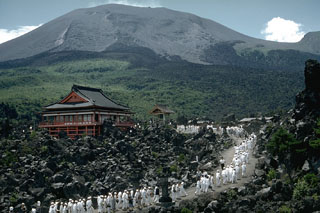Report on Asamayama (Japan) — 24 June-30 June 2020
Smithsonian Institution / US Geological Survey
Weekly Volcanic Activity Report, 24 June-30 June 2020
Managing Editor: Sally Sennert.
Please cite this report as:
Global Volcanism Program, 2020. Report on Asamayama (Japan) (Sennert, S, ed.). Weekly Volcanic Activity Report, 24 June-30 June 2020. Smithsonian Institution and US Geological Survey.
Asamayama
Japan
36.406°N, 138.523°E; summit elev. 2568 m
All times are local (unless otherwise noted)
On 25 June JMA raised the Alert Level for Asamayama to 2 (on a scale of 1-5) noting that inflation on the W flank had been recorded since 20 June. The number of shallow (just below the summit, or 1-2 km a.s.l.) volcanic earthquakes had also increased; two volcanic tremors were detected on 20 June. Emissions form the summit crater had not changed and continued to be white in color and rise no more than 200 m above the crater rim.
Geological Summary. Asamayama, Honshu's most active volcano, overlooks the resort town of Karuizawa, 140 km NW of Tokyo. The volcano is located at the junction of the Izu-Marianas and NE Japan volcanic arcs. The modern Maekake cone forms the summit and is situated east of the remnant of an older andesitic volcano, Kurofuyama, which was destroyed by a late-Pleistocene landslide about 20,000 years before present (BP). Growth of a dacitic shield volcano was accompanied by pumiceous pyroclastic flows, the largest of which occurred about 14,000-11,000 BP, and by growth of the Ko-Asamayama lava dome on the east flank. Maekake, capped by the Kamayama pyroclastic cone that forms the present summit, is probably only a few thousand years old and has observed activity dating back at least to the 11th century CE. Maekake has had several major Plinian eruptions, the last two of which occurred in 1108 (Asamayama's largest Holocene eruption) and 1783 CE.

